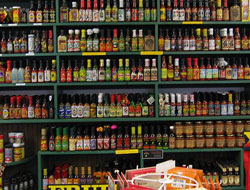Retail distribution centres and ecommerce give manufacturers - and parcel specialists - profitable new options.

The demand for FMCG hasn't diminished, but now the emphasis is shifting more towards the 'Fast' aspect of the acronym. (Image: Tom Harpel, via Wikimedia Commons)
Fifty years ago, it was taken as read that any manufacturing corporation would own warehouses and a fleet of distribution vehicles. It was a simple fact of business; manufacturers had to move goods from the factory to the retailer's back door. As a result, retailers were never in complete control of their supply chains. Faced with any unexpected demand for stock, they were to some extent at the mercy of the manufacturer's delivery schedule.
Today, this system is seen as inefficient and wasteful - and quite possibly facing extinction.
"Two decades ago, far sighted retailers began to realise that the cost of logistics, and the congestion at their back doors could be reduced if they established their own distribution centres (DCs)," says Diederick Stopforth, National sales and marketing manager at SkyNet Worldwide Express, local courier and express parcel (CEP) specialists. "That way, they can buy in bulk and distribute accurately and efficiently from the DC to various stores. Shoprite and Edgars, were leaders and have been doing this for decades. It's now become a standard feature of large retail chains. Lower distribution costs, and an ability to reduce the lead times between order and delivery were the drivers"
Changing patterns fuel CEP boom
The global economic recession is another factor behind the change in distribution systems. From manufacturers to retailers, businesses are attempting to keep lower levels of inventory to reduce both finance and warehousing costs.
"Manufacturers want to spend less on storing both supplies and finished product; retailers want to keep stock as low as they can while still keeping up with demand," says Stopforth. "Although the cost of an express parcel delivery is higher than the traditional transport method, it enables manufacturers to reduce stock throughout the system and to virtually eliminate the risk of obsolete or over stock positions. These users are working out that being on the shelf with the right product at the right place and time is crucial. It's an old logistics adage but it still holds. In the 21st century world, we use digital information and speed, not mountains of stock to achieve the same result.
"To cope with the demand, SkyNet currently uses 800 short-haul and 100 long-haul vehicles daily, through 35 distribution hubs, to service 450 towns countrywide."
The CEP business is also a major beneficiary of ecommerce in the B2C market. "With more and more people shopping online and expecting their purchases to be delivered speedily, there are huge opportunities in the CEP sector - which we're obviously very pleased about," says Stopforth.
"Look, some purchases are always going to involve a trip to the store - I can't see someone buying high-end jewellery or an engagement ring over the internet. However, the distribution of books, for example, has changed out of all recognition. You can still buy a real book online, or you can choose to simply buy the content and download it. Grocery shopping via the net is taking a while to catch on, but more and more people are trying it. Online shopping in general is growing at more than 30% per year; it's definitely a market we expect to keep expanding."
Therefore, although the traditional distribution models may be disappearing, the demand for FMCG certainly is not. Manufacturers and retailers alike have simply rediscovered the meaning of the first word in the acronym.











































